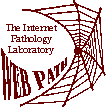- What is the diagnosis?
Infective endocarditis.
- Explain how this occurred.
The physical findings point to intravenous drug use, and persons who use drugs in this fashion are not usually following sterile technique. Thus, there is a decided risk for infection. The most common organism in this setting is Staphylococcus aureus, but other bacteria such as Pseudomonas or Streptococcus may be the cause. Also, most IV drug users are infected with hepatitis B and/or hepatitis C (which do not cause endocarditis). Some may be infected with HIV.
The aortic valve has nearly been destroyed by large friable vegetations that are composed of fibrin with bacterial colonies and numerous neutrophils.
- Explain how the gross appearance of the mitral valve shown in image 4.3 relates to this same disease process.
The fishmouth mitral valve seen here is typical for the scarring caused by chronic rheumatic heart disease. An abnormal cardiac valve is a predisposing factor for infective endocarditis (usually the subacute variety and usually with streptococcal organisms).
- Explain how the microscopic appearance in image 4.4 tells you something about complications of this disease as well as the site of involvement.
This microabscess has resulted from a septic embolus that broke off from the friable vegetation of infective endocarditis. The fact that this microabscess is in the lung indicates that the infected valve is on the right side of the heart. Most right-sided infective endocarditis occurs in IV drug users (although right and left-sided lesions are about evenly divided in IV drug users with infective endocarditis).
- What is the treatment?
Intravenous antibiotic therapy must be started as soon as possible--as soon as the diagnosis is suspected. Blood cultures can be drawn for definitive diagnosis along with determination of sensitivity patterns to antibiotics. For staphylococcal infections, oxacillin plus gentamicin or tobramycin can be effective. Streptococci of the viridans group typically respond to penicillin G. Resistant S. pneumoniae may respond to ceftriaxone. Enterococci may respond to ampicillin plus gentamicin. Additional antibiotics for resistant organisms can include vancomycin and aminoglycosides.
- Name some other causes for these lesions on a cardiac valve.
The forms of non-infective endocarditis include: marantic (non-bacterial thrombotic) endocarditis; Libman-Sacks endocarditis (seen with collagen vascular diseases); verrucous endocarditis with acute rheumatic fever.
- What would the radial blood pressure curve look like in this disorder?
There would be an elevated systolic pressure (due to increased filling of the left ventricle through the incompetent valve and thus a Starling effect) and a reduced diastolic pressure (due to runoff both back into the LV and out to the body), hence a wide pulse pressure.
- What arrhythmia would be seen most often in chronic mitral valve insufficiency?
The reflux through the valve would cause atrial dilation. The increased volume of the chamber would be an excellent substrate for multiple reentry pathways leading to atrial fibrillation.



